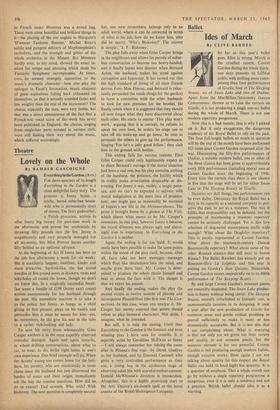Ballet
Ides of March
By CLIVE BARNES Now this is a bad month; that is why I picked on it. But it only exaggerates the dangerous tendency of the Royal Ballet to rely on the past. The four full-length ballets so much in question will by the end of the month have been performed 923 times since Covent Garden reopened after the war. Discounting the fifty-five performances of Ondine, a notable modern ballet, one or other of the three classics has been given at approximately every fifth performance (including opera) seen at Covent Garden since the beginning of 1946. Every time the curtain rises there is one chance in five that the stage will be set for either Swan Lake or The Sleeping Beauty or Giselle.
Statistics are dull things, but performances can be even duller. Obviously the Royal Ballet has a duty in its capacity as a national company to pre- serve the past, to act as a museum. The way it fulfils that responsibility can be debated, but the principle of maintaining a museum repertory cannot be seriously challenged. Yet is this tiny selection of dog-eared masterpieces really wide enough? What about the Diaghilev repertory? This is poorly represented at Covent Garden. What about the nineteenth-century Danish Bournonville repertory? What about some of the other Russian classics that still exist in Soviet Russia? The Ballet Rambert has already put on Bournonville's La Sylphide and this year is putting on Gorsky's Don Quixote. Meanwhile Covent Garden moves majestically on to its 400th performance of The Sleeping Blowy.
By and large Covent Garden's museum pieces are execrably displayed. The Swan Lake p'roduc- tion is funny without being clever. The Sleeping Beauty, recently refurbished at fantastic cost, is monumentally tasteless in its designing. It took a year after the new production of Giselle for common sense and gentle critical prodding to prevail sufficiently to make it more or less dramatically acceptable. But it is not this that I am complaining about. What is worrying is that not only are we given too little variety and quality in our museum pieces, but the museum element is far too powerful. Covent Garden is not producing enough modern ballets, enough creative works. Here again I an not talking about quality (in this respect the Royal Ballet can hold its head high) but quantity. It is a question of emphasis. That a whole month can go by without a single repertory programme is dangerous, even if it is only a tendency and not a practice. British ballet should take it as a warning.


































 Previous page
Previous page